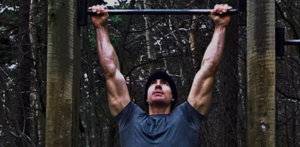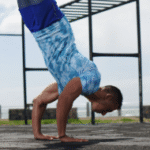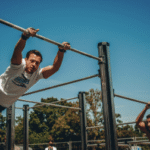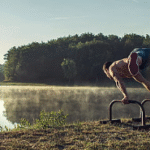7 Essential Calisthenics Progressions for Strength
Calisthenics progressions are a systematic way to gradually increase the difficulty of bodyweight exercises, allowing you to continually challenge yourself and make progress toward your fitness goals. Whether you’re a beginner just starting or an experienced athlete aiming for advanced skills, understanding and implementing progressions is crucial for long-term success in calisthenics. Here are 7 essential calisthenics progressions for strength:
- Push-Up Progressions
Wall Push-Ups: Start with wall push-ups to build a foundation of upper body strength. Gradually increase the incline by moving your feet further away from the wall.
Incline Push-Ups: Progress to incline push-ups using a bench, chair, or other elevated surface. As you get stronger, lower the incline until you can perform standard push-ups.
Standard Push-Ups: Master the standard push-up with proper form, keeping your body in a straight line from head to heels.
Decline Push-Ups: Increase the challenge by elevating your feet on a low platform. This puts more weight on your upper body, making the exercise harder.
Variations: Explore variations like diamond push-ups (hands close together), archer push-ups (one arm bent), and eventually, one-arm push-ups.
- Pull-Up Progressions
Assisted Pull-Ups: If you can’t do a full pull-up yet, start with assisted pull-ups using resistance bands or a pull-up assist machine. Gradually reduce the assistance as you get stronger.
Negative Pull-Ups: Jump or use a box to get to the top position of a pull-up, then slowly lower yourself down with control. This strengthens the muscles involved in the pulling motion.
Standard Pull-Ups: Once you can perform several pull-ups with good form, focus on increasing your repetitions.
Weighted Pull-Ups: Add weight using a weight belt or vest to further challenge your muscles and increase strength.
Variations: Explore variations like chin-ups (underhand grip), wide-grip pull-ups, and archer pull-ups (one arm pulling).
- Squat Progressions
Chair Squats: If you’re new to squats, start with chair squats. Sit down on a chair and stand back up, using the chair for support.
Assisted Squats: Hold onto a sturdy object for balance as you perform squats. Gradually reduce the assistance as you get stronger.
Standard Squats: Master the standard squat with proper form, keeping your back straight and your knees aligned with your toes.
Bulgarian Split Squats: Elevate one foot behind you on a bench or platform and perform squats. This increases the challenge and works on single-leg strength.
Variations: Explore variations like jump squats, pistol squats (single-leg squats), and weighted squats.
- Dip Progressions
Bench Dips: Start with bench dips using a bench or chair for support. Place your hands on the edge of the bench, lower your body, and push back up.
Assisted Dips: Use resistance bands or a dip assist machine to reduce the difficulty. Gradually decrease the assistance as you get stronger.
Standard Dips: Perform dips on parallel bars or a dip station, keeping your body upright and your elbows close to your sides.
Weighted Dips: Add weight using a weight belt or vest to increase the challenge and build strength.
Variations: Explore variations like ring dips (using gymnastic rings) for added instability and muscle activation.
- Row Progressions
Inverted Rows: Lie under a bar or sturdy object and pull your chest towards the bar. This strengthens your back muscles and prepares you for pull-ups.
Australian Pull-Ups: Use a low bar or sturdy object and perform pull-ups with your feet on the ground. This is a great way to build pulling strength and progress towards standard pull-ups.
Pull-Ups: Once you can perform several pull-ups, focus on increasing your repetitions and exploring variations like chin-ups and wide-grip pull-ups.
- Core Progressions
Plank: Start with a standard plank, holding the position for as long as possible. Gradually increase the hold time as you get stronger.
Side Plank: Challenge your obliques with side planks, holding the position on each side for as long as possible.
Leg Raises: Perform lying leg raises or hanging leg raises to strengthen your lower abdominals.
Variations: Explore variations like hollow body holds, dragon flags, and L-sits to further challenge your core strength and stability.
- Calf Raise Progressions
Standard Calf Raises: Stand tall and raise up onto the balls of your feet, then lower back down.
Elevated Calf Raises: Stand on an elevated platform to increase the range of motion and challenge your calf muscles further.
Single-Leg Calf Raises: Perform calf raises on one leg at a time to increase the intensity and improve balance.
Tips for Implementing Progressions
Master the Basics: Before moving on to more challenging variations, ensure you have mastered the basic exercises with proper form.
Gradual Progression: Progress gradually, increasing the difficulty in small increments to avoid injuries and ensure consistent progress.
Listen to Your Body: Pay attention to any pain or discomfort and adjust your training accordingly.
Consistency: Be consistent with your training, aiming for regular workouts to see continuous improvement.
Variety: Incorporate a variety of exercises and progressions to keep your workouts challenging and engaging.
By understanding and implementing these essential calisthenics progressions, you can continually challenge your body, build strength, and achieve your fitness goals. Remember to prioritize proper form, listen to your body, and enjoy the journey of mastering your bodyweight and becoming stronger.

7 Essential Calisthenics Progressions for Strength
Route
Calisthenics Gym Houston Functional Bodyweight Training
Secondary phone: (346) 483-3195
Email: info@calisthenicsclubhouston.com
URL: https://calisthenicsclubhouston.com/
Monday 6:00 AM - 7:00 PM Tuesday 6:00 AM - 7:00 PM Wednesday 6:00 AM - 7:00 PM Thursday 6:00 AM - 7:00 PM Friday 12:00 PM - 6:30 PM Saturday 9:45 AM - 12:00 PM Sunday 3:00 PM - 5:00 PM





